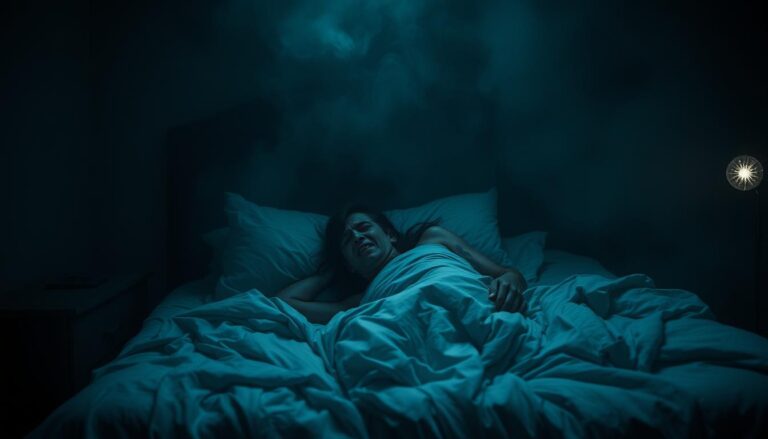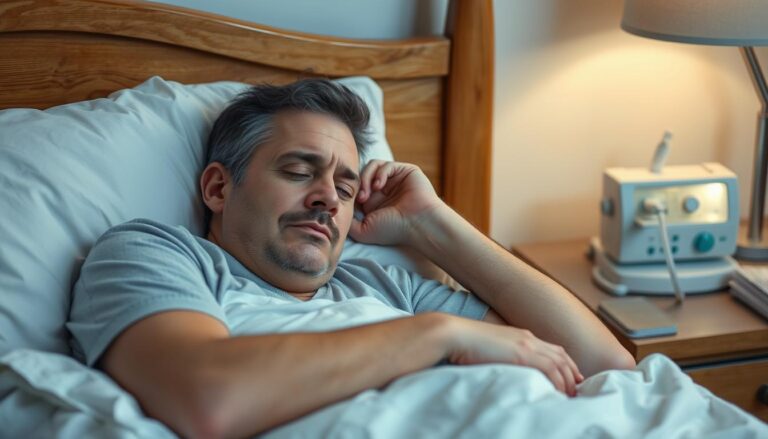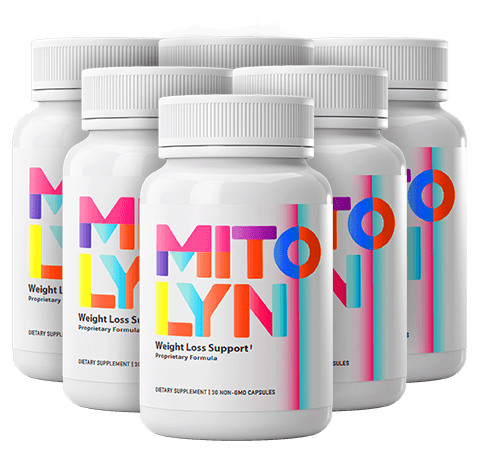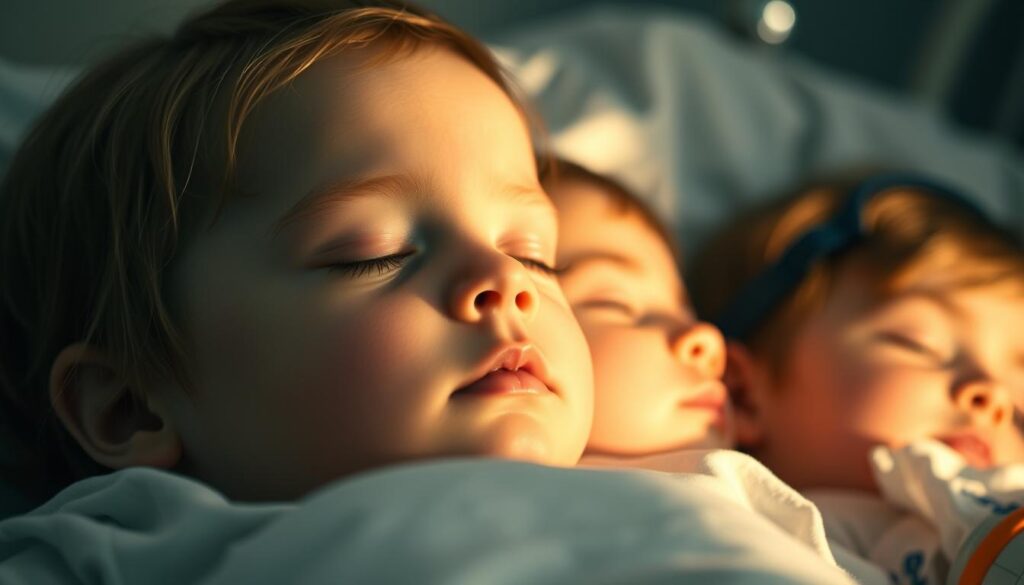
Does your child snore loudly or seem to stop breathing during sleep? Pediatric sleep apnea isn’t just for adults. Up to 1-5% of kids face this issue. It happens when breathing stops and starts during sleep, often because of blocked airways.
If your child is between 2 and 8 years old, they’re at the highest risk. This is because enlarged tonsils and adenoids are the main causes.
Can my child have sleep apnea? This question is very important. Children with Down syndrome are at even higher risk, with 53-76% affected. Signs like daytime sleepiness, learning struggles, or behavioral issues could mean childhood sleep apnea.
If left untreated, it can lead to serious problems. These include high blood pressure or heart murmurs. It’s crucial to act early.
Key Takeaways
- Pediatric sleep apnea affects 1-5% of children, often linked to enlarged tonsils.
- Snoring and breathing pauses are common signs in 20-30% of children, though many go undiagnosed.
- Untreated cases can cause learning delays, irritability, or weight gain in 30-40% of affected kids.
- Most diagnoses involve sleep studies, and treatments range from surgery to CPAP therapy.
- About 30% of children with mild OSA may outgrow it without intervention.
Understanding Pediatric Sleep Apnea
Understanding childhood sleep apnea is crucial for early action. Here’s what you need to know:
What Is Sleep Apnea in Children?
Childhood obstructive sleep apnea (OSA) happens when breathing stops briefly during sleep. This is because airways are blocked. Most kids with OSA have big tonsils or adenoids, not just being overweight.
This is different from adults, where being overweight is a big factor.
How Common Is Sleep Apnea in Kids?
- About 1-5% of children have sleep apnea, most between ages 2-8.
- Children born early are 9.4% more likely to have it.
- Only about 1 in 10 kids with severe cases (AHI over 5) need urgent care.
The Difference Between Adult and Childhood Sleep Apnea
| Aspect | Adults | Children |
|---|---|---|
| Main Symptoms | Daytime sleepiness | Hyperactivity, trouble focusing |
| Risk Factors | Obesity, age | Large tonsils/adenoids |
| Common Treatments | Weight loss, CPAP | Tonsil/adenoid removal |
Knowing these differences helps spot signs early. If your child acts differently instead of being sleepy, they might have sleep apnea.
Can My Child Have Sleep Apnea? Recognizing the Risk Factors
Knowing the risk factors for pediatric sleep apnea helps you spot potential issues early. Let’s break down what to watch for.
Age-Related Risk Factors
Children between 2 and 6 years old face the highest risk. This is because their tonsils and adenoids are bigger compared to their airways. These enlarged tissues block airflow, making preschoolers 3–5 times more likely to develop symptoms.
Even younger kids or teens can have childhood sleep apnea. But, causes may differ with age.

Physical Characteristics That Increase Risk
Some physical traits raise the likelihood of sleep apnea:
- Enlarged tonsils or adenoids (most common cause)
- Obesity, especially in teens (60% of obese children show symptoms)
- Small jaw structure or craniofacial anomalies
- Narrow airways from genetic conditions
Medical Conditions Associated With Sleep Apnea
Children with these health issues face higher risks:
- Genetic syndromes like Down syndrome or Prader-Willi syndrome
- Neuromuscular disorders or cerebral palsy
- Sickle cell disease or low birth weight
- A family history of sleep apnea
If your child has any of these factors, talk to their doctor about monitoring or testing. Early action can prevent long-term effects like growth delays or behavioral struggles.
Common Symptoms of Sleep Apnea in Children
Spotting symptoms of sleep apnea in children starts with noticing changes in how your child sleeps. Loud, persistent snoring is a big red flag. But, there are other clues too. Brief pauses in breathing or restless movements during the night could mean a problem.
“Pauses in breathing lasting longer than a few seconds need immediate medical attention,” warn sleep specialists.
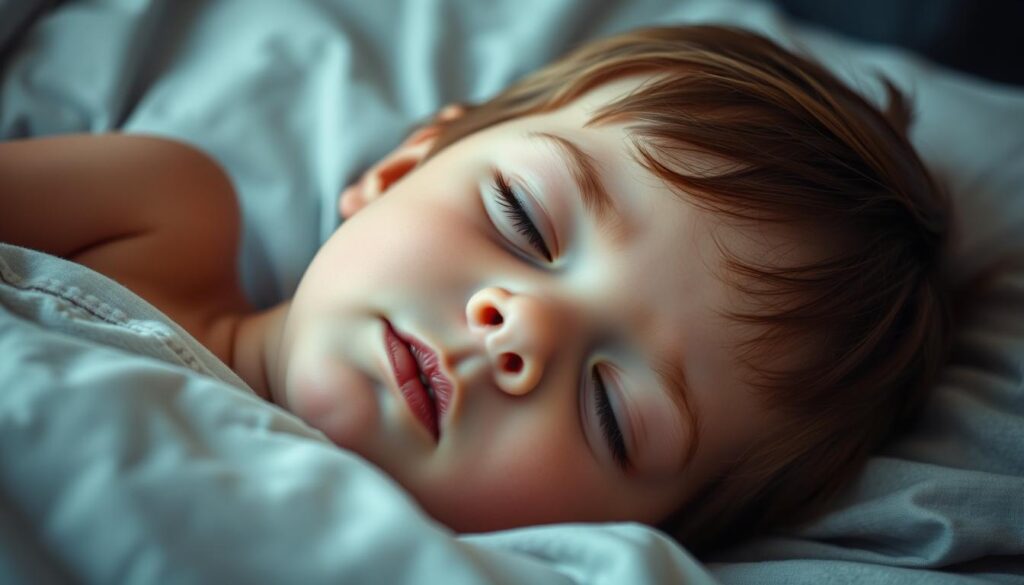
- Snoring that occurs nightly or worsens over time
- Breathing stops for 10 seconds or longer, followed by gasping or snorting
- Moving constantly in bed or sleeping in unusual positions
- Mouth breathing instead of nasal breathing
- Heavy sweating unrelated to room temperature
- Bed-wetting after a period of staying dry
Not all children show obvious signs. Infants might seem fussy or have shallow breathing without loud snoring. Pauses in breathing lower oxygen levels, forcing the brain to wake briefly to restart airflow. This disrupts deep sleep, leading to daytime tiredness or behavioral changes.
If these signs of sleep apnea in kids appear, contact your pediatrician. Early care can prevent heart strain or developmental delays.
Nighttime Signs Your Child Might Have Sleep Apnea
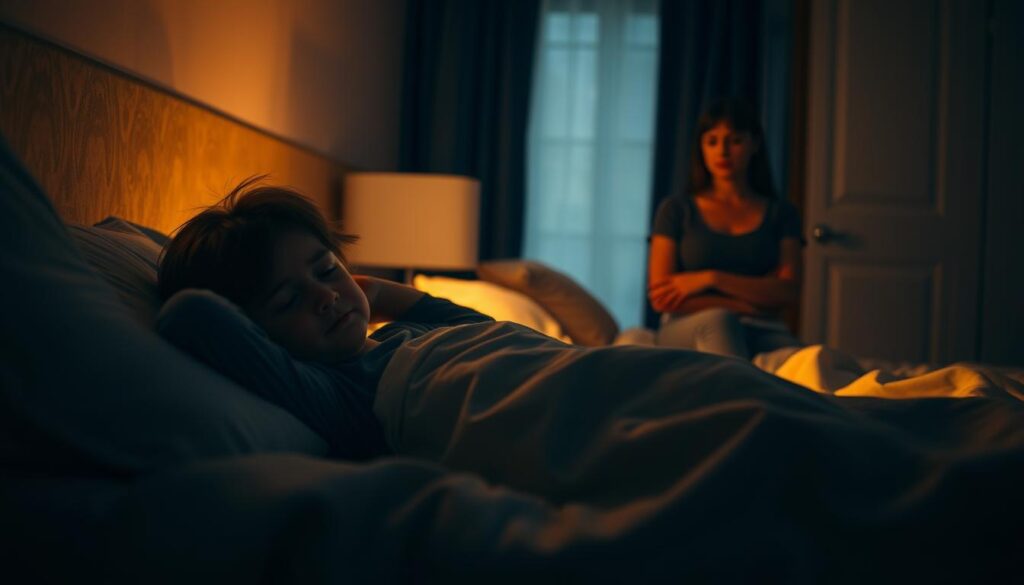
Have you noticed unusual noises or movements while your child sleeps? Childhood obstructive sleep apnea can disrupt nighttime rest in subtle ways. Look for these specific signs of sleep apnea in kids during sleep:
Snoring and Breathing Patterns to Watch For
Snoring isn’t always harmless. If your child snores loudly three or more nights a week, listen closely. Pauses in breathing followed by gasps or snorts could signal blocked airways. These pauses happen when oxygen levels drop, forcing the brain to briefly wake them to restart breathing.
Sleep Positions and Movements That May Indicate Sleep Apnea
Children with sleep apnea often twist and turn to breathe easier. Watch for:
- Arching the neck backward to open airways
- Sleeping in seated or forward-leaning positions
- Restlessness—frequent tossing and turning
Other Concerning Nighttime Behaviors
Beyond sounds and positions, these behaviors may point to childhood obstructive sleep apnea:
- Bedwetting after being potty-trained
- Excessive sweating during sleep
- Sudden sleep terrors or nightmares
If your child shows multiple signs, talk to their pediatrician. Early detection can prevent long-term effects on growth and learning.
Daytime Symptoms That May Suggest Childhood Sleep Apnea
Daytime symptoms of sleep apnea in children can be easy to miss. Morning headaches, trouble focusing in school, or acting too hyper might mean childhood sleep apnea. These signs show the brain isn’t getting enough oxygen at night.

- Morning headaches caused by low oxygen levels at night.
- Mouth breathing or trouble breathing through the nose.
- Daytime sleepiness or falling asleep in class or the car.
- Difficulty concentrating, leading to lower grades or frustration in school.
- Behavior changes, like irritability, aggression, or hyperactivity.
| Childhood Sleep Apnea Symptoms | Similar to ADHD Symptoms |
|---|---|
| Morning headaches, frequent fatigue | None |
| Daytime sleepiness, learning struggles | Hyperactivity, impulsivity |
| Behavioral issues, mood swings | Difficulty following rules |
Up to 5% of children have childhood sleep apnea. But many are thought to have ADHD instead. If your child’s teacher talks about attention problems or you see these signs, see a pediatrician. Early treatment can help sleep, grades, and behavior without surgery or medicine.
The Impact of Untreated Sleep Apnea on Your Child’s Health
Ignoring childhood obstructive sleep apnea can cause big problems for your child. If pediatric sleep apnea is not treated, it can mess up their daily life and health for years to come. Knowing these risks helps you act fast.
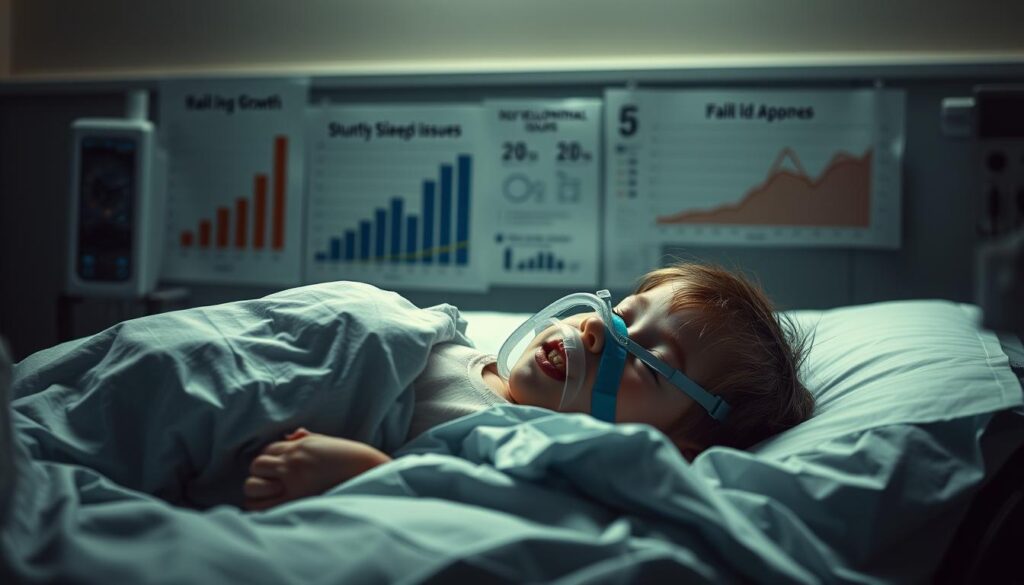
Short-Term Effects on Behavior and Performance
- Irritability and frequent mood swings
- Difficulty focusing in school or following directions
- Hyperactivity or restless behavior during the day
Long-Term Health Consequences
Without treatment, can my child have sleep apnea is a big worry. Risks include:
- High blood pressure and heart strain
- Increased risk of type 2 diabetes due to blood sugar imbalances
- Chronic fatigue affecting physical and mental health
Effects on Growth and Development
Growth hormone is released during deep sleep. Children with untreated sleep apnea may:
- Experience slower height growth
- Show delayed developmental milestones
- Face irregular weight patterns, including failure to thrive in infants
Untreated cases may also lead to learning challenges. Studies show 75-80% of children improve after adenoid/tonsil removal. But delays in treatment can make things worse. Early intervention protects their future health and well-being.
How Doctors Diagnose Sleep Apnea in Kids
Learning about diagnosing sleep apnea in kids helps parents know what to expect. This makes sure your child gets the right care without stress. Here’s a simple guide to the evaluation steps.
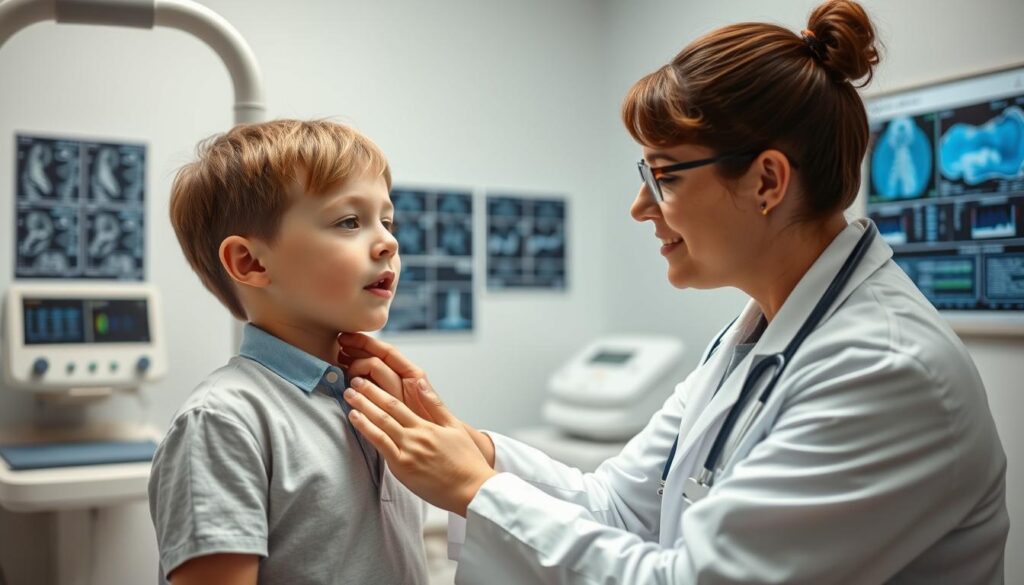
Initial Evaluation and Physical Examination
Doctors start by looking at your child’s health history. They check for snoring, sleep problems, or growth issues. A physical exam looks at the mouth, throat, and neck for big tonsils or adenoids.
They also ask about allergies, sleep position, and family health. This helps find out if your child is at risk.
Diagnostic Tools and Tests
Important tests include:
- A polysomnogram (sleep study) records brain waves, breathing, and oxygen levels at night. It’s a painless test for pediatric sleep apnea diagnosis.
- Nasal endoscopy uses a flexible scope to look at the airway.
- Oxygen monitors track blood oxygen levels at home for some cases.
What to Expect During the Diagnostic Process
Most kids sleep in a lab-like room with sensors. Parents can stay nearby. The results help decide treatment.
Tests like X-rays or imaging scans might be needed for structural issues. Families get clear instructions after the tests.
Treatment Options for Pediatric Sleep Apnea
Effective treatment for pediatric sleep apnea depends on your child’s unique situation. For childhood obstructive sleep apnea caused by enlarged tonsils or adenoids, surgery is often the first step. Adenotonsillectomy—removing these tissues—can resolve symptoms in many cases. But if your child’s apnea persists or is due to other factors like obesity, other approaches may be needed.
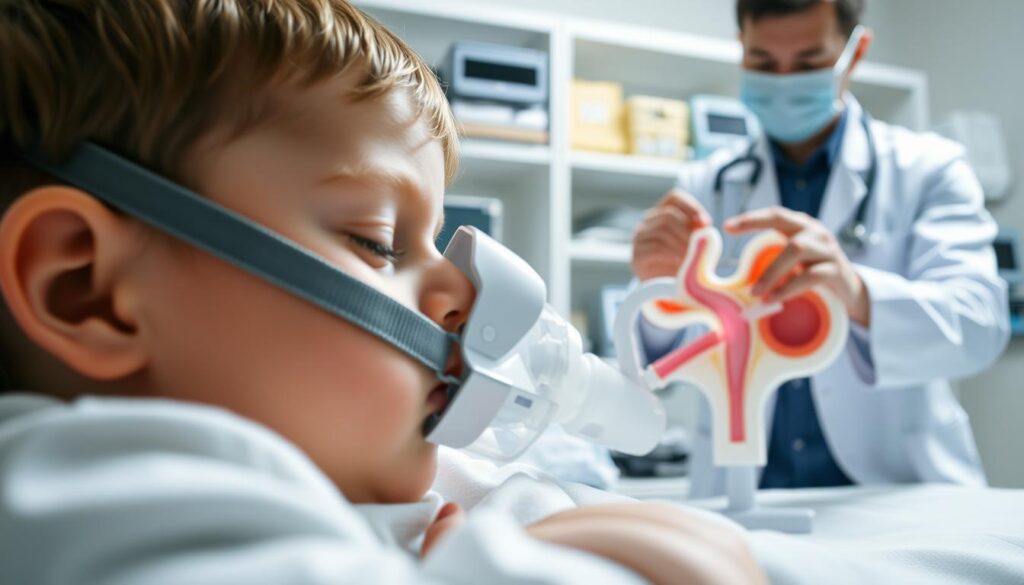
- Surgery: Removing tonsils or adenoids works for 70% of children, but 21-73% might need follow-up care. Obese children have higher relapse rates.
- CPAP therapy: A mask delivers steady air pressure during sleep. While tricky at first, adherence improves with practice. Pediatricians suggest starting with short sessions.
- Medications: Nasal sprays like budesonide reduce airway swelling. Studies show they cut apnea events by over 60% in mild cases. Steroids or anti-inflammatory drugs can also help.
- Lifestyle changes: Weight management programs and exercise plans reduce symptoms in obese children. Positional therapy—sleeping on the side—may ease breathing.
Doctors may combine these options. For example, combining nasal sprays with weight loss guidance improves outcomes. Research shows 55% symptom improvement with multi-approach plans. Always discuss risks and benefits with your child’s care team to choose the best path.
When to Seek Medical Help for Suspected Sleep Apnea
If you’re wondering, “can my child have sleep apnea,” knowing when to act is key. Signs of sleep apnea in kids like snoring, gasping, or pauses in breathing need prompt action. Early diagnosis can prevent issues like learning struggles or growth delays. Here’s how to act fast and prepare for care. 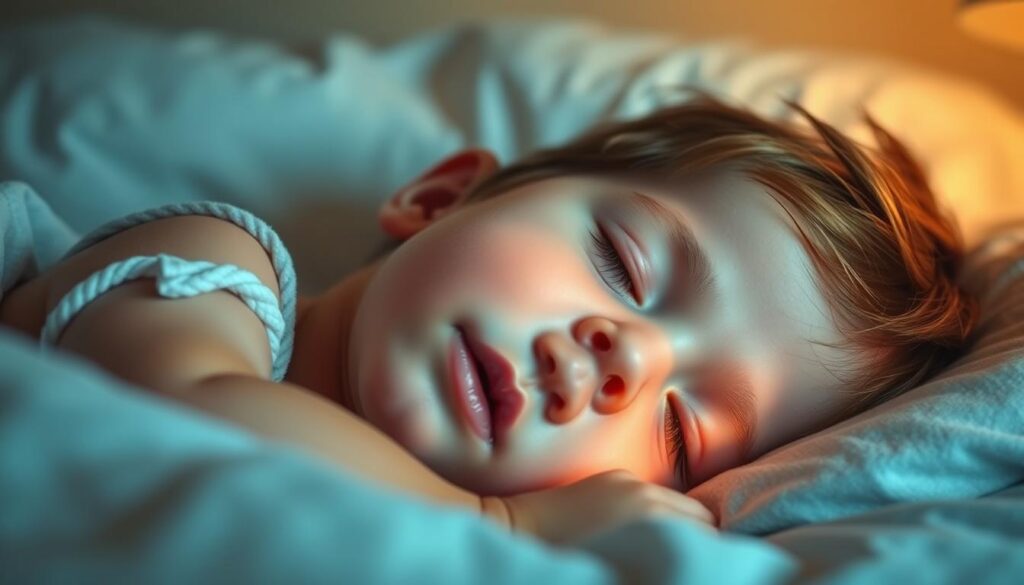
Warning Signs That Require Immediate Attention
- Snoring that’s loud and frequent
- Pauses in breathing lasting 20+ seconds
- Gasping, choking, or struggling to breathe
- Daytime fatigue, irritability, or behavioral issues
- Turning blue or sweating excessively during sleep
Seek emergency care if your child stops breathing, turns blue, or shows signs of distress. These are critical signs of sleep apnea requiring immediate help.
Preparing for Your Child’s Doctor Appointment
Prepare a sleep diary noting: snoring frequency, breathing patterns, and daytime behaviors. Record audio/video of sleep sounds if possible. Share family medical history, especially sleep disorders or conditions like Down syndrome. Bring a list of current medications and symptoms’ timeline.
| Key Statistic | Data |
|---|---|
| Children with sleep disorders | 7%–11% of all children |
| Undiagnosed cases | 90% of cases go unnoticed |
| Arkansas Children’s Hospital | Top-rated for pediatric sleep care |
Questions to Ask Your Pediatrician
- What tests are needed for diagnosing sleep apnea in kids?
- Are sleep studies required? Will they be done overnight?
- Should we consider a specialist, like an ENT or sleep physician?
- What lifestyle changes can help before or after treatment?
- How soon will we see improvements after treatment?
Ask about Arkansas Children’s Hospital’s sleep center if specialized care is needed. Their nationally ranked program offers comprehensive diagnosing sleep apnea in kids.
Conclusion: Supporting Your Child Through Sleep Apnea Diagnosis and Treatment
Spotting sleep apnea in kids early is crucial. Look out for loud snoring, brief pauses in breathing, or tiredness during the day. These could mean your child has sleep apnea.
Ignoring these signs can harm your child’s learning, behavior, and growth. About 20% of kids who snore have sleep apnea. So, knowing the signs is important for parents.
Treatment for kids with sleep apnea depends on the case. Some need surgery, while others use CPAP machines or make lifestyle changes. Over 60% of kids get better with CPAP, showing the importance of early treatment.
Your doctor will pick the best treatment for your child. This could be surgery, managing weight, or dental work. Early treatment can fix problems like low growth hormones and brain delays.
Working with doctors is key to your child’s care. Regular check-ups and home monitoring help track progress. Most kids sleep better, focus more, and have more energy after treatment.
Acting fast and supporting your child’s care helps avoid serious problems. With the right care, kids can do well in school and behave better. Stay on top of things, and your child will breathe easier and grow stronger.








